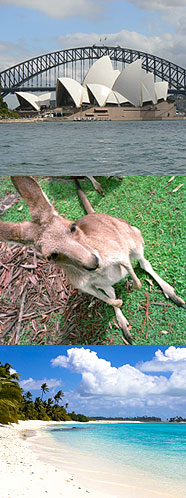Australian History 101
Australia 's original inhabitants, the aborigines, arrived in a series of migrations from Southeast Asia more than 40,000 years ago. There were as many as 600 distinct groups of aborigines living throughout Australia when Dutch mariners explored parts of the west and southern coasts in the early 17th century.
Although traders from Asia had probably been making contact for centuries, aboriginal culture and language survived untouched by the outside world until 1770, when Captain James Cook claimed the eastern coast for Great Britain . The British landed at what became Sydney in 1788 and founded a penal colony (a place for criminals) under Captain Arthur Phillip.
The first free settlers arrived in the struggling new town of Sydney in 1791. For a time, the colony came under the control of the corrupt NSW Corps, or "Rum Corps," (yes, they were named after the alcoholic beverage given they consumed so much of it) whose officers did much as they pleased under a state of virtual martial law.
Australian soils and climate, with the recurrent droughts that plague the land to this day, were better suited for large-scale grazing than for farming. The most successful and dramatic transformation of the Australian continent occurred in the 1830s and 1840s, as squatters established huge sheep runs. Paying only a small amount per year for a license, squatters could claim virtually as much land as they wanted. It used to be said that in economic terms, Australia "rode on the sheep's back." Some Australians, such as the infamous Ned Kelly, rode on the wrong side of the law.
From 1830 to 1850, wool exports rose from £2 million to £41 million. With new immigrants and the growth of the capital cities, each serving as the major port for its region, Australian colonies began to agitate for self-government, a measure of which the crown granted in 1850. Following the discovery of gold a year later, the number of free people emigrating to Australia multiplied many times over.
In principle, the official colonial policy throughout the 19th century was to treat aborigines as equals, with the intention of eventually converting them to Christianity and European civilization. The Governor of the time, Governor Macquarie, established a school for aboriginal children.
Such well-intentioned acts, however, were infrequently supported. In the face of resistance from warlike tribes, Tasmania 's early colonial government moved from a policy of protection to one of persecution. The last original Tasmanian, Truganini, died in 1876. In the 1830s and 1840s, as the frontier pushed inland, some aborigines were employed on sheep stations, and others worked in police patrols, but even some active church efforts to serve and educate the aborigines did not stabilize race relations. White settlers poisoned and hunted aborigines and abused and exploited aboriginal women and children.
Where graziers sought lands for their sheep runs, the aboriginal communities of hunters were made to retreat into the drier interior. Forced to survive on even scantier supplies of food, aborigines were steadily reduced in number. By the 20th century their traditional lifestyles were confined to the Northern Territory , Queensland , and the western regions of New South Wales.
It was not until the 1960s that aborigines were afforded full citizenship rights. As governments have subsequently pursued policies of land rights and reconciliation, aboriginal Australians today constitute about 1.5 percent of the population. Their own distinctive black, gold, and red flag is recognized by the Federal Government, as is that of the Torres Strait Islands.
In 1896 women of South Australia won the right to vote—the first in the world. In 1901 the colonies, which by that time totaled six, agreed to federate as the Commonwealth of Australia. New Zealand withdrew at the last moment, leaving New South Wales , Victoria , Queensland , Tasmania , South Australia , and Western Australia as the founding states. The new government convened in Melbourne until 1926, when it was moved to the Federal Capital of Canberra.
The Great Depression of the 1930s was a time of high unemployment and widespread suffering in Australia . Its effects were felt longer and more deeply in Australia than in many other countries.
During World War I , Australia sent tens of thousands of soldiers overseas, more than half of whom were killed or wounded. During WWII, Australians served in all theaters of the war, with the bloodiest fighting in the jungles of New Guinea , where a Japanese invasion of Australia was narrowly averted. Darwin and several other northern Australian towns were bombed. In the Korean War (1950–53) Australian forces served with the United Nations, of which it was a founding member. During the Vietnam War (1959–75) Australian forces supported the United States.
After WWII, there was more than two decades that was generally regarded as a golden era of prosperity. The population exploded after the war as hundreds of thousands of immigrants were encouraged to make Australia home


